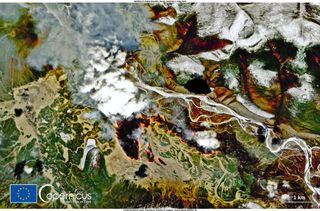'Zombie wildfires' that smoldered beneath the snow in Siberia are raging again
Fires smoldering below the tundra all winter are making their debut early this year, officials say.

Hundreds of fires are raging across Russia as wildfire season descends on the world's largest country ahead of schedule, according to news reports.
Some parts of the country have already reported a record number of spring wildfires, according to The Siberian Times, and smoke plumes from some Siberian forest fires have drifted across half the nation and been spotted over Finland (that's nearly 2,000 miles, or 3,200 km — the equivalent of a fire in New York drifting to Albuquerque, New Mexico). In late April, wildfire smoke blacked out the sky in the Siberian city of Novosibirsk — Russia's third most populous city — prompting the government to issue a "black sky" health warning.
#Smoke (lavender/magenta shading) from #Siberia #fires continues moving west, reaching #Finland, #Estonia & #BalticSea today 13 May, verified by #VIIRS aerosol detection composite from #SNPP & #NOAA20.@m_parrington @Pierre_Markuse @AntonBoym @JPSSProgram @Karma_lobsang pic.twitter.com/ItqKt2wqbRMay 13, 2021
An intense spring heatwave is partially responsible for this year's early blazes, News.ru reports, making fires sparked by lightning strikes and human activity more likely. But some of these wildfires may be the rekindled remains from last summer's fires — also known as "zombie" fires.
Zombie wildfires occur when ice and snow cover a flame, but don't fully extinguish it. This phenomenon is common in the Arctic tundra, where carbon-rich peat can fuel smoldering flames all winter, Live Science previously reported. When the spring melt arrives, those underground embers can be rekindled, igniting new wildfires.
Related: 'Zombie' greenhouse gas lurks in permafrost below the Arctic Ocean
A video filmed in February 2021 in Yakutia — a Russian republic infamous for being one of the coldest places on Earth — showed what these zombie fires can look like. In the video, a man — standing in snow up to his ankles in a field — digs down to reveal a layer of peat. Smoke seeps out of the hole, steaming into the freezing air. Besides being an eerie sight, these zombie fires release tons of carbon and methane from the peat, contributing to global warming.
This year's early warming trend is unsurprising. In 2020, Russia set a number of alarming heat records, including Siberia's hottest May on record. The region broke other records too; on June 20, temperatures in the northern Siberian town of Verkhoyansk broke 100 degrees Fahrenheit (38 degrees Celsius) for the first time, becoming the hottest-ever temperature documented above the Arctic Circle, Live Science reported.
Sign up for the Live Science daily newsletter now
Get the world’s most fascinating discoveries delivered straight to your inbox.
Originally published on Live Science.

Brandon is the space/physics editor at Live Science. His writing has appeared in The Washington Post, Reader's Digest, CBS.com, the Richard Dawkins Foundation website and other outlets. He holds a bachelor's degree in creative writing from the University of Arizona, with minors in journalism and media arts. He enjoys writing most about space, geoscience and the mysteries of the universe.